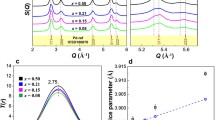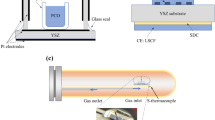Abstract
Nonstoichiometric mixed ionic and electronic conductors (MIECs) find use as oxygen permeation membranes, cathodes in solid oxide fuel cells, oxygen storage materials in three-way catalysts, and chemoresistive gas sensors. Praseodymium–cerium oxide (PrxCe1-xO2-δ) solid solutions exhibit MIEC behavior in a relatively high and readily accessible oxygen partial pressure (PO2) regime and as such serve as model systems for investigating the correlation between thermodynamic and kinetic properties as well as exhibiting high performance figures of merit in the above applications. In this paper, we extend recently published results for Pr0.1Ce0.9O2-δ to include values of x 5 0, 0.002, 0.008, 0.1, and 0.20 (in PrxCe1-xO2-δ) to test how both defect and transport parameters depend on Pr fraction. Important observed trends with increasing x include increases in oxygen ion migration energy and MIEC and reductions in vacancy formation and Pr ionization energies. The implications these changes have for potential applications of PrxCe1-xO2-δ are discussed.














Similar content being viewed by others
References
H. Inaba and H. Tagawa: Ceria-based solid electrolytes. Solid State Ionics 83, 1–16 (1996).
B.C.H. Steele: Appraisal of Ce1-yGdyO2-y/2 electrolytes for IT-SOFC operation at 500 °C. Solid State Ionics 129, 95–110 (2000).
H.L. Tuller and A.S. Nowick: Defect structure and electrical properties of nonstoichiometric CeO2 single crystals. J. Electrochem. Soc. 126, 209–217 (1979).
H.L. Tuller and A.S. Nowick: Small polaron electron transport in reduced CeO2 single crystals. J. Phys. Chem. Solids 38, 859–867 (1977).
S.B. Adler: Factors governing oxygen reduction in solid oxide fuel cell cathodes. Chem. Rev. 104, 4791–4843 (2004).
C. Chatzichristodoulou, P.V. Hendriksen, and A. Hagen: Defect chemistry and thermomechanical properties of Ce0.8PrxTb0.2−xO2. J. Electrochem. Soc. 157, B299–B307 (2010).
S.R. Bishop, T.S. Stefanik, and H.L. Tuller: Electrical conductivity and defect equilibria of Pr0.1Ce0.9O2-δ. Phys. Chem. Chem. Phys. 13, 10165–10173 (2011).
H.L. Tuller and S.R. Bishop: Point defects in oxides: Tailoring materials through defect engineering. Annu. Rev. Mater. Res. 41, 369–398 (2011).
T.S. Stefanik and H.L. Tuller: Nonstoichiometry and defect chemistry in praseodymium-cerium oxide. J. Electroceram. 13, 775–778 (2004).
D. Chen, S.R. Bishop, and H.L. Tuller: Praseodymium-cerium oxide thin film cathodes: Study of oxygen reduction reaction kinetics. J. Electroceram. 28, 62–69 (2012) DOI: 10.1007/s10832-011-9678-z.
S.R. Bishop, J.J. Kim, N. Thompson, D. Chen, Y. Kuru, T. Stefanik, and H.L. Tuller: Mechanical, electrical, and optical properties of (Pr, Ce)O2 solid solutions: Kinetic studies. ECS Trans. 35, 1137–1144 (2011).
D. Marrocchelli, S.R. Bishop, H.L. Tuller, and B. Yildiz: Understanding chemical expansion in non-stoichiometric oxides: Ceria and zirconia case studies. Adv. Funct. Mater. DOI: 10.1002/adfm.201102648.
S.R. Bishop, H.L. Tuller, Y. Kuru, and B. Yildiz: Chemical expansion of nonstoichiometric Pr0.1Ce0.9O2-δ: Correlation with defect equilibrium model. J. Eur. Ceram. Soc. 31, 2351–2356 (2011).
Y. Kuru, S.R. Bishop, J.J. Kim, B. Yildiz, and H.L. Tuller: Chemomechanical properties and microstructural stability of nanocrystalline Pr-doped ceria: An in situ x-ray diffraction investigation. Solid State Ionics 193, 1–4 (2011).
T.S. Stefanik: Electrical properties and defect structures of praseodymium-cerium oxide solid solutions. Ph.D. Thesis, Massachusetts Institute of Technology, Cambridge, MA, 2004.
J. Van Herle, T. Horita, T. Kawada, N. Sakai, H. Yokokawa, and M. Dokiya: Low temperature fabrication of (Y, Gd, Sm)-doped ceria electrolyte. Solid State Ionics 86–88, 1255–1258 (1996).
C. Chatzichristodoulou and P.V. Hendriksen: Oxygen nonstoichiometry and defect chemistry modeling of Ce0.8Pr0.2O2-d. J. Electrochem. Soc. 157, B481–B489 (2010).
S.R. Bishop, K.L. Duncan, and E.D. Wachsman: Surface and bulk oxygen non-stoichiometry and bulk chemical expansion in gadolinium-doped cerium oxide. Acta Mater. 57, 3596–3605 (2009).
J. Faber, C. Geoffroy, A. Roux, A. Sylvestre, and P. Abelard: A systematic investigation of the dc electrical conductivity of rare earth doped ceria. Appl. Phys. A 49, 225–232 (1989).
W. Lai and S.M. Haile: Impedance spectroscopy as a tool for chemical and electrochemical mixed conductors: A case study of ceria. J. Am. Ceram. Soc. 88, 2979–2997 (2005).
R. Gerhardt-Anderson and A.S. Nowick: Ionic conductivity of CeO2 with trivalent dopants of different ionic radii. Solid State Ionics 5, 547–550 (1981).
V. Butler, C.R.A. Catlow, B.E.F. Fender, and J.H. Harding: Dopant ion radius and ionic conductivity in cerium dioxide. Solid State Ionics 8, 109–113 (1983).
D.A. Andersson, S.I. Simak, N.V. Skorodumova, I.A. Abrikosov, and B. Johansson: Optimization of ionic conductivity in doped Ceria. Proc. Natl. Acad. Sci. U.S.A. 103, 3518–3521 (2006).
J.A. Kilner and C.D. Waters: The effects of dopant cation oxygen vacancy complexes on the anion transport properties of nonstoichiometric fluorite oxides. Solid State Ionics 6, 253–259 (1982).
R.D. Shannon: Revised effective ionic radii and systematic studies of interatomic distances in halides and chalcogenides. Acta Crystallogr. Sect. A 32, 751–767 (1976).
M.A. Panhans and R.N. Blumenthal: A thermodynamic and electrical conductivity study of nonstoichiometric cerium oxide. Solid State Ionics 60, 279–298 (1993).
Y-P. Xiong, H. Kishimoto, K. Yamaji, M. Yoshinaga, T. Horita, M.E. Brito, and H. Yokokawa: Electronic conductivity of pure ceria. Solid State Ionics 192, 476–479 (2011).
H. Yahiro, Y. Eguchi, K. Eguchi, and H. Arai, Oxygen Ion Conductivity of the Ceria Samarium Oxide System with Fluorite Structure, J. Appl. Electrochem. 18, 527–531 (1988).
T. Kudo and H. Obayashi, Mixed electrical conduction in the fluorite-type Ce1-xGdxO2-x/2, J. Electrochem. Soc. 123, 415–419 (1975).
H. Yahiro, T. Ohuchi, K. Eguchi, and H. Arai, Electrical properties and microstructure in the system ceria alkaline-earth oxide, J. Mater. Sci. 23, 1036–1041 (1988).
K. L. Duncan, Y. Wang, S. R. Bishop, F. Ebrahimi, and E. D. Wachsman: Role of point defects in the physical properties of fluorite oxides. J. Am. Ceram. Soc. 89, 3162–3166 (2006).
Acknowledgment
This research was funded by the Division of Materials Research, National Science Foundation under the Material World Network (DMR-0908627) in collaboration with Prof. Ralf Moos, Universität Bayreuth. S.R.B. recognizes partial support from I2CNER, supported by the World Premier International Research Center Initiative, MEXT, Japan. H.L.T. thanks I2CNER for hosting his visit during the time this manuscript was prepared. The authors wish to thank the reviewer for identifying potential intrinsic electronic conduction for undoped ceria in high pO2.
Author information
Authors and Affiliations
Corresponding author
Rights and permissions
About this article
Cite this article
Bishop, S.R., Stefanik, T.S. & Tuller, H.L. Defects and transport in PrxCe1−xO2−δ: Composition trends. Journal of Materials Research 27, 2009–2016 (2012). https://doi.org/10.1557/jmr.2012.130
Received:
Accepted:
Published:
Issue Date:
DOI: https://doi.org/10.1557/jmr.2012.130




